Scarves, have been a staple in men’s clothing for more than two thousand years. Historically worn by some of our world’s most prolific leaders, the scarf, a profound piece of neckwear has graced our necks for as long or longer
than neckties, bow ties and cravats. In this scarf guide, you will learn everything about the history, materials, and qualities, except how to tie a scarf, you can learn that here.
The History of the Scarf
The scarf certainly has some religious connotations but has also enjoyed use for warmth, cleanliness and of course fashion. While many credit its history to use by the Terracotta soldiers in China, the scarf dates all the way back to ancient Rome where it was originally called a Sudarium, literally translated to mean “sweat cloth”. It was used in Rome for cleanliness, and the cloth scarf was often worn tied to the waist of the man, or loosely wrapped around the neck on warmer days. In the event of a formal affair, the scarf was almost always worn, and various grades of cloth could easily separate the affluent and wealthy members of society from the rest. The scarf was now seen on a daily basis as men would continually wear them out, both for cleanliness, but now, due to the separation of class, as a way to showcase their status or elitism in society.
By the third century BC, the appeal and popularity of the Roman introduced scarf had made its way to China and was now being worn by the Terracotta soldiers of the Qin Shi Huang dynasty as a form of military garb in used as a way to discern the soldiers rank, based on the style or fashion of the scarf.
By the end of the nineteenth century, scarves had gone from a regular accessory worn by men and women to one of the most essential forms of neckwear worn on a daily basis by men of all classes. Since then, scarves have been a globally popular fashion accessory for men and today still provide the warmth, religious and protective qualities of a bygone era.
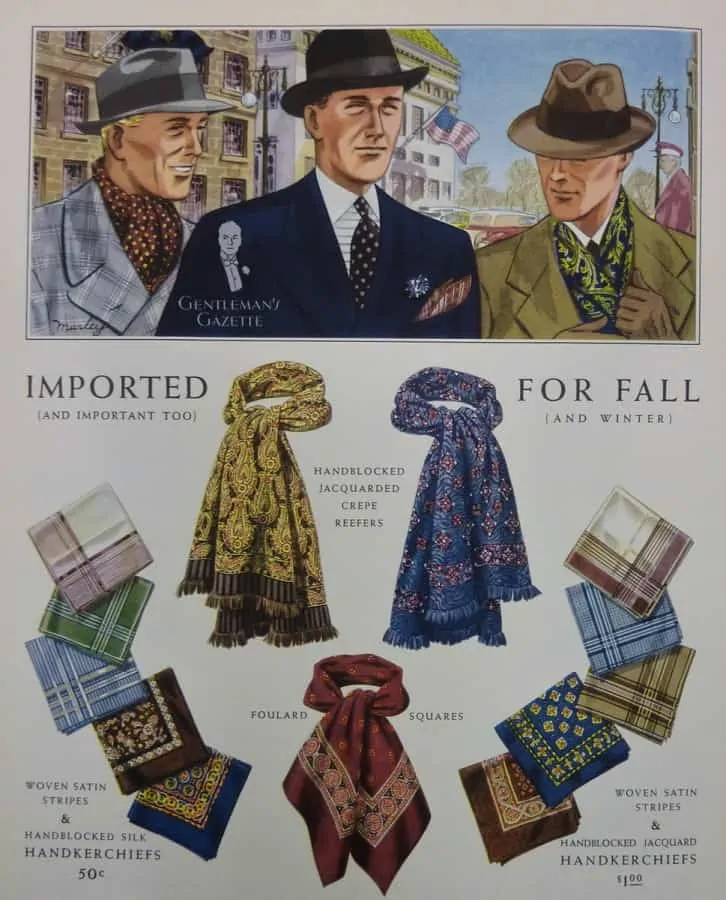
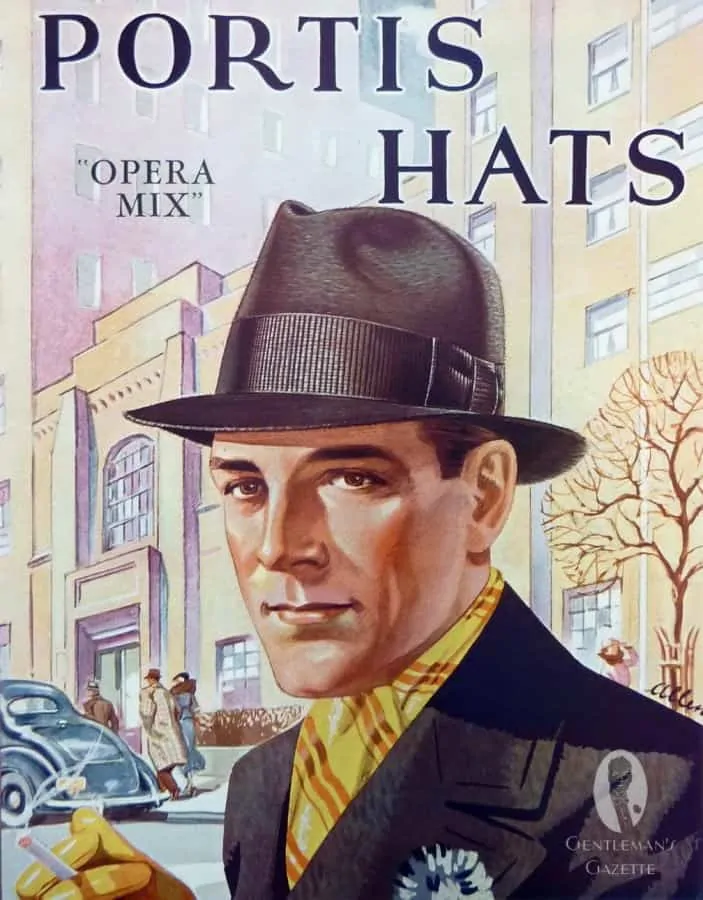
Popularized by Hollywood celebrities in movies and premieres, the scarf was seen on a regular basis draped loosely around the neck of both stars and starlets. As a contributing factor causing increased popularity, brands have popped up internationally dedicating themselves to the manufacturing of scarves either exclusively or in addition to other fashion lines. We only have to look at some of the most well-known brands in America such as Brooks Brothers, Ralph Lauren, and J. Press to see that even the largest haberdashers have introduced lines of scarves. Intertwine that with online retailers and makers such as scarf.com and Fort Belvedere.
Today, men wear scarves in various climate conditions, as both an accessory and protective layer during the cold winter months, and strictly as a fashionable accessory in warmer climates. In fact, it’s not unusual to see men strolling Rodeo Drive in Beverly Hills on a warm summer day, decked out in a linen or cotton scarf accompanying their scarf. In addition, it’s perfectly normal to see a man wearing a white or colored formal scarf draped over the nape of his neck at the opera or another black tie affair. For most men, a single scarf is no longer the norm. Many men own multiple scarves in various colors, patterns and made from many different fabrics.
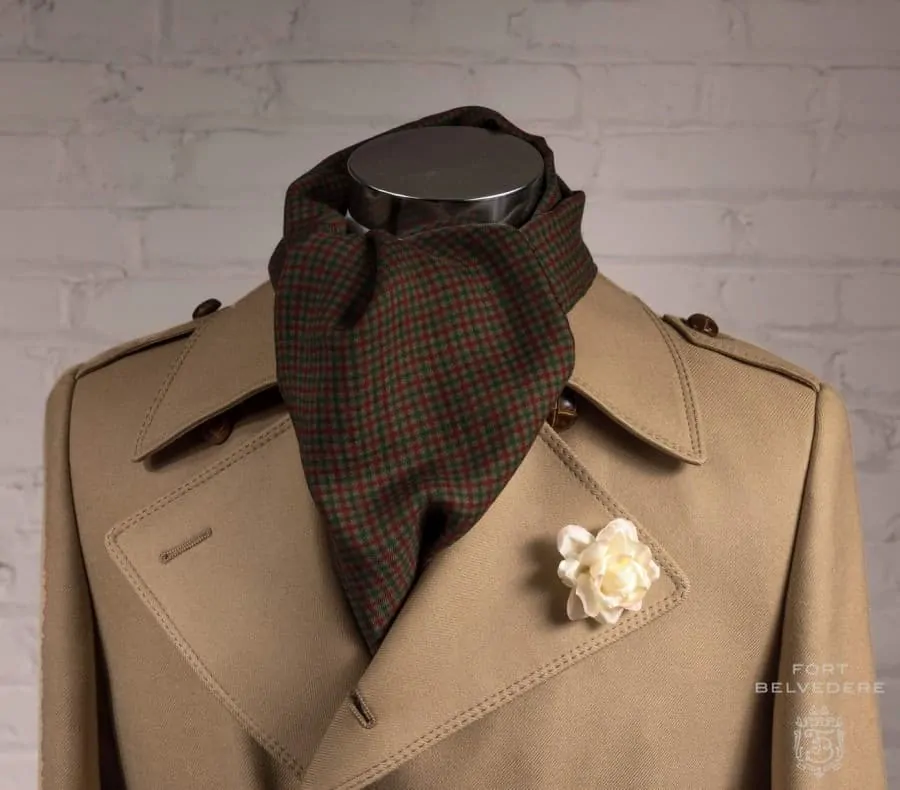
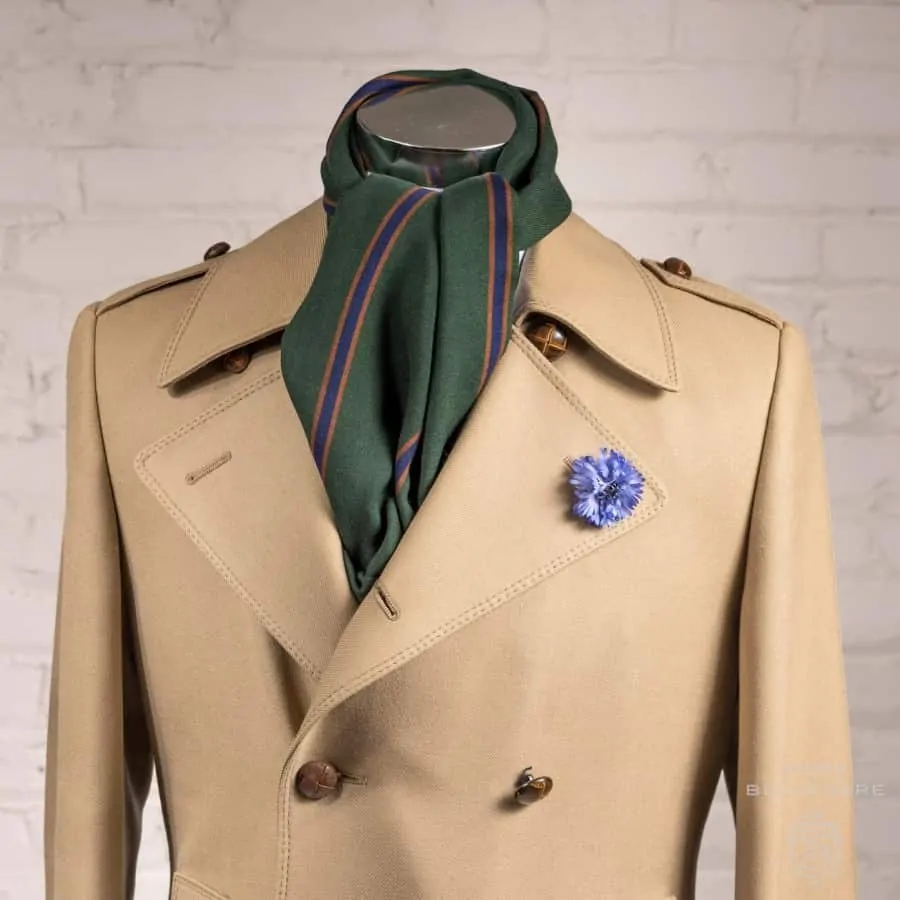
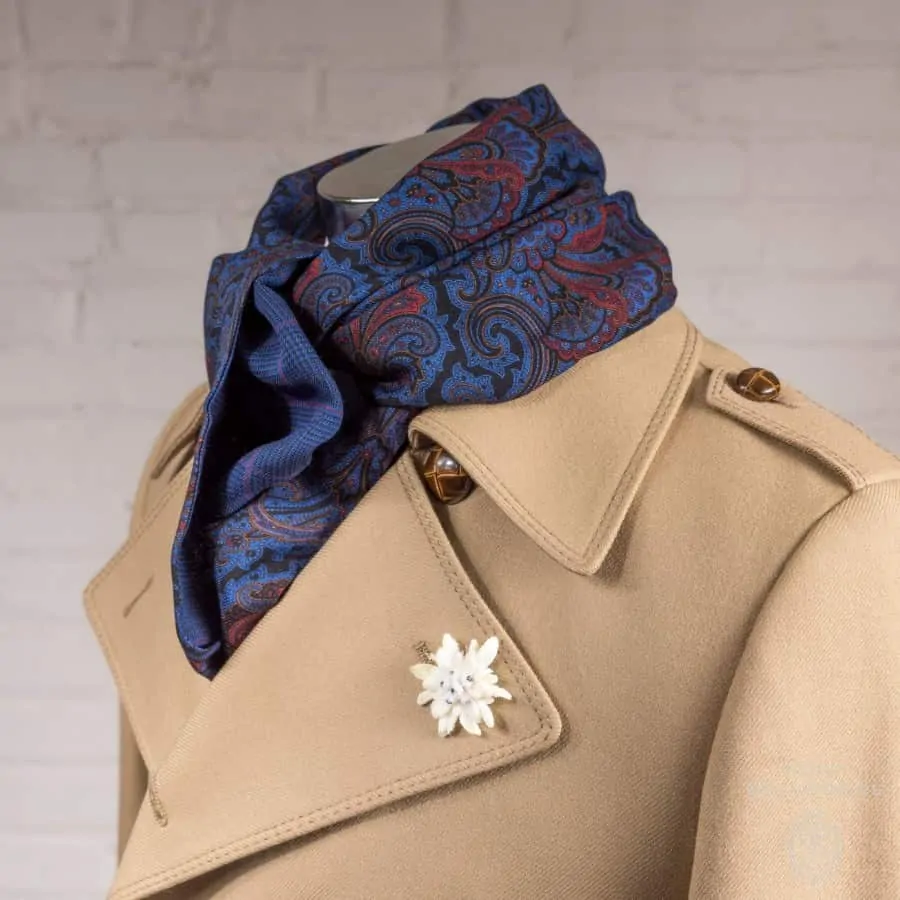
Types of Scarves
There are many styles of scarves in a wide variety of shapes, patterns and colors, made from many different types of materials.
There are five primary categories that scarves fit into when we discuss men’s attire. They are the following:
Casual / Winter Scarf
Often worn for protection from the elements, these scarves are made primarily of wool, cashmere, alpaca or polyester and are intended to be worn during the cold winter months. They can be printed or in various patterns and are often knitted and thick to the touch.
Sport Scarf
Often made of a thinner, yet cold resistant material, many companies such as UnderArmor, Reebok, and Nike make these winter scarves for winter athletes. These scarves are often made of a blend of materials and provide fairly high resistance to wind, snow, and temperature. Many of these scarves are circular and don’t need to be wrapped. This prevents the scarf from untangling and causing potential injury or death to athletes such as skaters, skiers and snowboarders. They are usually quite snug and can be pulled up to cover the mouth and nose and sometimes even the ears. In addition to being worn by professional and amateur athletes, these scarves are very popular with parents and children due to their ease of use and limited tangling capabilities making them a safer alternative for active play.
Business Casual Scarf
These scarves are usually quite thin similar to the sports scarves but made in the same fashion as the casual scarf, in other words – long and rectangular.
Often featuring checks, paisley or other geometric prints, these scarves are more traditional and are intended to be paired with business or semi-casual attire. These scarves are made from a variety of materials and can be worn in the winter or summer months. For warmer climates, these scarves are often made of cotton, jersey, cashmere, satin, silk, linen or pashmina which is a cashmere wool from the Pashmina goat. For cooler climates, wool, cashmere, alpaca and poly-blend materials are particularly popular. Often materials will be woven together to create a blended scarf which can provide more a more delicate touch with greater resistance to the inclement weather. For example, in Canada, cashmere and wool blended scarves are particularly popular for men as they are soft and thin from the cashmere wool, yet contain the protection of the coarser wool.
The Dress Scarf
Not quite the formal scarf, or the daywear, the evening scarf is an elegant addition to any gentleman’s topcoat or overcoat. Made of cashmere, alpaca, or even merino wool, the evening scarf is the middle sibling in the elegant scarf trifecta. Reversible or not, it is a conservative, sometimes with checks, plaids or paisley prints.
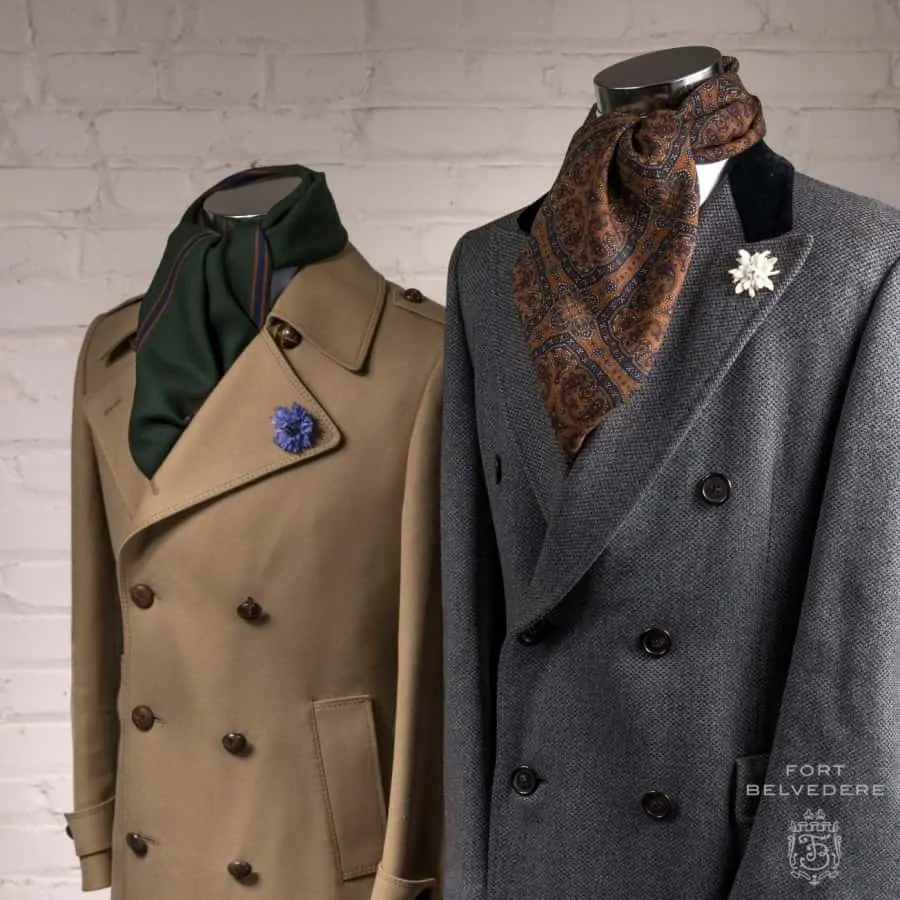
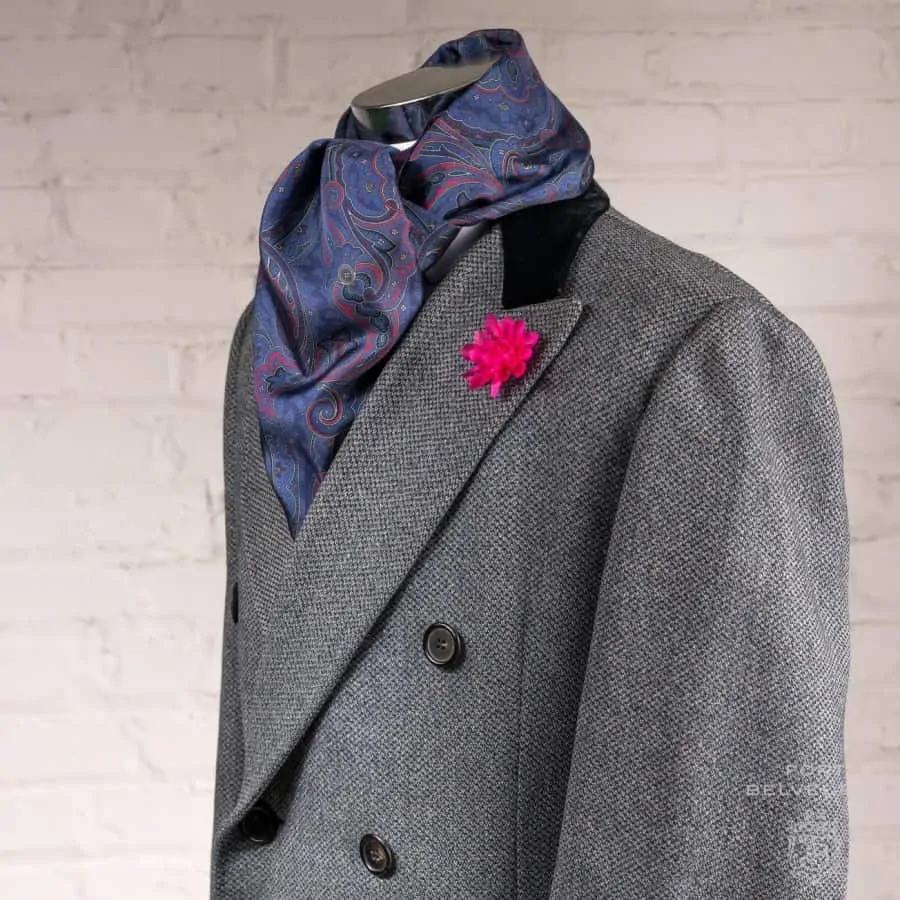
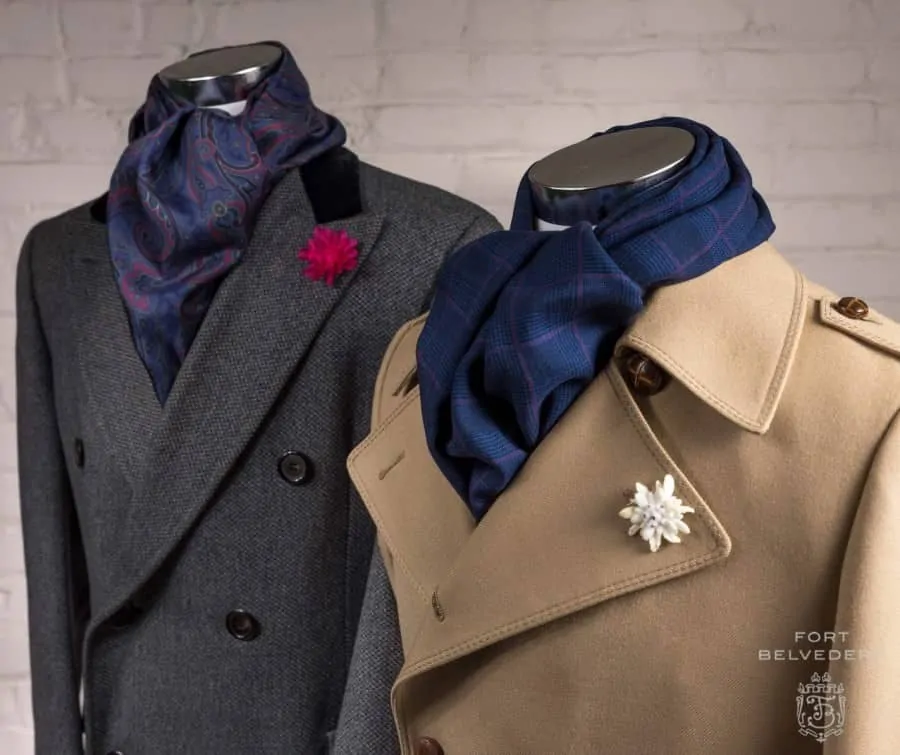
Formal Evening Scarf
Often worn with a tuxedo ortailcoat, the formal scarf is a fringed rectangular scarf usually made of silk satin and in most cases, made in black, white or a combination thereof. They often feature hand-knotted fringes and unlike other scarves, are not wrapped, but draped over the back of the neck and sometimes thrown over the shoulder.
Fashion / Summer Scarf
Designed specifically for use as a fashionable accessory, these scarves are often made of linen, cotton, silk, seersucker or pashmina and are worn strictly as a fashion statement and not generally as a protective layer to resist wind, snow or cold. Often worn with both casual and business attire, they feature a wide range of prints or textures.
Elegant Reversible Scarf
The reversible scarf, also known by the British as a tubular scarf,
Scarf Materials
Scarves as a whole can be made of a wide variety of materials and fabrics. For mens scarves, the following materials are the ones most commonly used in construction of the retangular scarf:
Polyester
The least admirable material possibly of all time, while there are both natural and synthetic forms of polyester, in most cases, during the manufacturing of clothing, it’s the synthetic variant being predominantly used. Despite polyester being viewed as an inferior material to that of naturally woven fibers like cotton and wool, the polyester woven scarves or polyblend scarves do have some exceptional qualities often incapable of being achieved when using an all natural fibre.
Polyester scarves benefit from superior resistance to inclement weather with a far greater success rate when it comes to repelling water, wind and snow. In addition, they offer exceptional wrinkle resistance, can be construed as more durable than many or most of the their counterparts and offer high color retention, resulting in the scarf lasting much longer under the extreme elements.It is for these reasons in particular that polyester and poly-blend scarves are incredibly popular with children and professional athletes. In some instances, since polyester is considered a less elegant material, it is often woven with natural fibers which
It is for these reasons in particular that polyester and poly-blend scarves are incredibly popular with children and professional athletes. In some instances, since polyester is considered a less elegant material, it is often blended with natural fibers which provides the polyester based scarf with other visual and textural properties normally not found with synthetic polyester.
Just as a 100% polyester bow tie is easy to spot in comparison to a silk bow tie, a scarf made exclusively of polyester is just as easy to differentiate from a silk scarf. By blending the polyester with silk, cotton or other natural fibers, you can obtain what’s often called “China Silk”.
Jersey
Jersey is most often used in the production of feminine scarves as its conducive to embellishments, rather than just prints or textures. It holds sequins, beads and other externally sewn embellishments quite well as it’s a fairly thin and stretchy cotton. Despite being used predominantly for womens apparel, it has recently and historically been used by men, especially in warmer Middle East climates and can often be seen on some middle eastern members of the royal family.
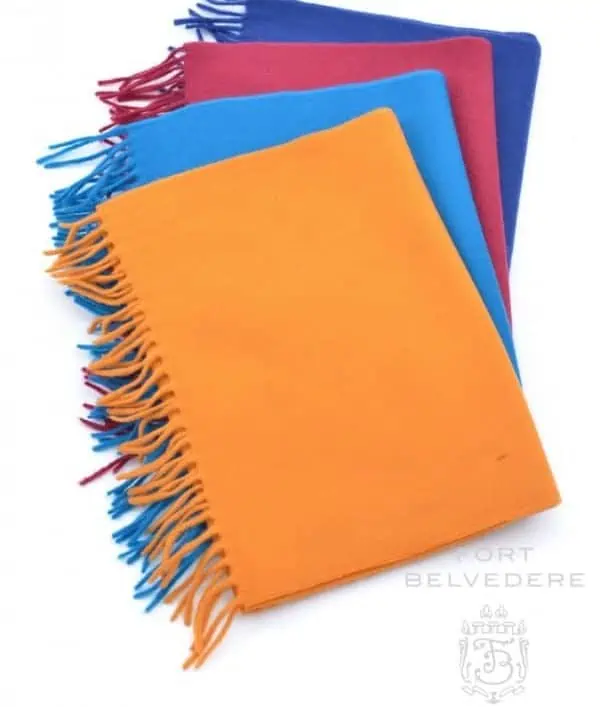
Cashmere
An exquisitely soft and luxurious wool, cashmere is woven from from the yarn of fine underhair of the cashmere goat. Each goat produces only 150 – 200 grams a year, which is just enough for a single scarf. Unlike, many other materials it actually becomes softer over time and is widely considered the gold standard for many luxury articles of clothing from sweaters to scarves and socks. Despite being very lightweight, it still maintains adequate protection from the cold. It is one fabric often blended with other wools or even polyester, because of its price. However, always bear in mind that you can find huge difference in the quality of cashmere.
At Fort Belvedere, we source only high-quality cashmere yarns. The best quality cashmere is usually between 14 and 16.5 microns thick, which is one of the reasons for its softness. With a staple length of 35 – 50mm, we ensure that the scarf won’t pill easily, so you can wear it for years to come. Cashmere from Iran (17.5 – 19 micron) and Afghanistan (16.5-18 micron) is less desireable because it is rougher and pills more easily. Also, bear in mind that most inexpensive cashmere scarves are woven from the short 2nd or 3rd quality cashmere yarn, that was spun from very short cashmere hair. Moreover, natural white and lighter colored cashmere is much more expensive than darker grayish or brown cashmere, because only the lighter colored underhair can be dyed into our vivid colors. The darker fibers can only be used for dark colors.
While top quality cashmere typically features less than 0.5% of guard hair, cheaper quality scarves often contain more than 5% of guard hair, which is rougher and less desirable. In the next step, Fort Belvederecashmere fibers are then treated with natural thistles, which roughen up the surface of the scarf to create a particularly soft feel. Using real thistles is costly, but this traditional method guarantees top quality. When we examined Scottish cashmere scarves, which are often advertised as premium quality, we learned that thistles are not used anymore which reveals a decline in quality. After a Fort Belvedere scarves are woven, they undergo the milling process, which provides the cashmere with fullness and softness. Another part of this process is done the traditional way, employing wooden rollers. Of course, every scarf undergoes extensive Quality Control by skilled weavers, in order to assure you receive the highest quality Fort Belvedere cashmere scarf.
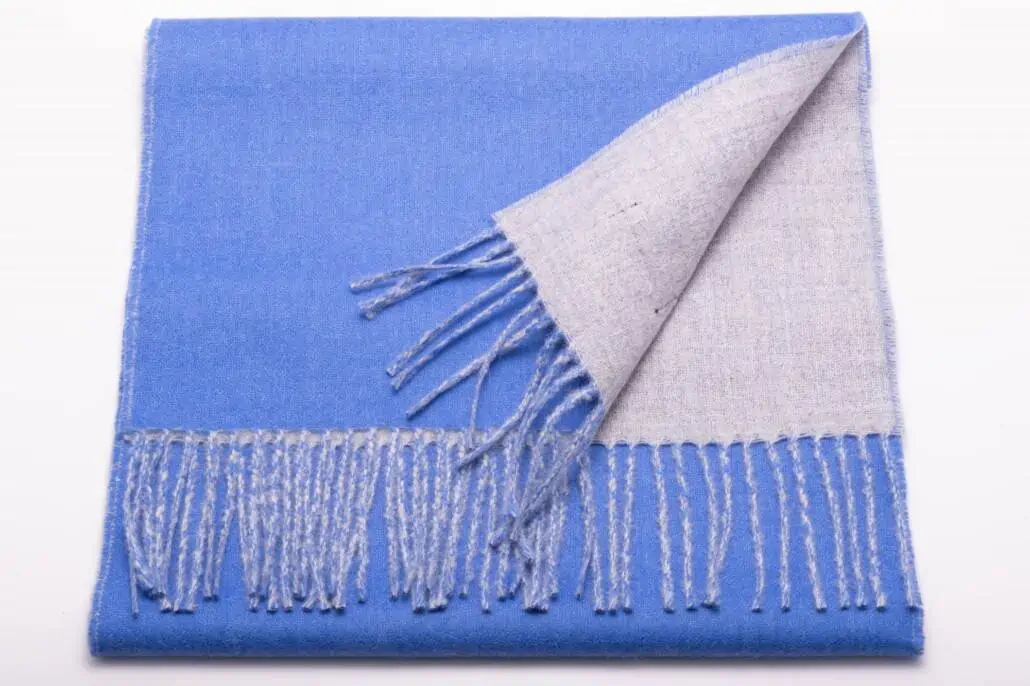
Alpaca
Often confused both with a camel and a llama, the Alpaca is a domesticated camelid from South America. The wool of the alpaca is similar to the sheep but far more luxurious and significantly warmer, because the fibers are hollow and have an air chamber. It has a silky shine to it and is one of my favorite natural fibers. The best alpaca qualities in the world come from Peru and are designated as baby & royal baby Alpaca indicating a thicknesses between 19 – 22 micron. Obviously this is thicker than the best cashmere qualities, but due to the softer surface of Alpaca fibers it feels almost as soft as the best cashmere qualities. Therefore Alpaca scarves are the perfect companion if you want a warm but soft scarf.
Alpaca comes in 24 natural colors, with white being the most popular because it can be dyed in the most shades. Generally, the natural white fibers are of slightly superior quality, which is why Fort Belvedere only uses white fibers. Alpaca does not have lanolin usually found in wool or cashmere, which makes it the perfect material for people otherwise allergic to wool or animal hair.
Looking for Quality Scarves?
Silk
A natural fiber, it’s harvested from the larvae cocoons of the mulberry silkworm. One of the most elegantly viewed fibers in the world, silk is the basis for the vast majority of high-quality accessories and all forms of neckwear. When buying a bow tie, necktie or cravat, you certainly want to seek out 100% silk-made ties unless of course, you’re specifically looking for something like a cotton or linen tie for a summer ensemble. Silk is often imitated but never duplicated. It can be shiny or matte but is always exquisite and delicately refined. When it comes to scarves, silk can be found as the basis for many formal scarves that are paired gracefully with a dinner jacket or tails. Here you can see how silk screen printing is done – every color needs an individual screen, so the more colors a design has, the more complicated and labor-intensive it is.
Cotton
Not often found in scarves intended for practical purpose, cotton is a cool and light fabric that is perfect for warmer climates due to its breathability. Often found in the cooler, yet warm climates of Southern California, cotton scarves are incredibly popular with the hipster demographic, but also the dandies of today and businessmen looking to impart some personal flair into an otherwise monotonous wardrobe.
Linen
Derived from the flax plant, linen is without question, equivocation or mental reservation, the lightest and coolest fabric for fashionable scarves. We know linen from the suits, pants and shirts we wear in the summer and the Irish linen handkerchiefs we carry in our pockets. For fashion scarves in the summer months or warm climates, it’s tough to beat linen. In addition, linen can actually help to keep you cooler under the hot sun and provide some protection for your skin.
Pashmina
Originally, produced using the delicate under hair of goats from the Kashmir region in India, pashmina used to be a very thin, delicately woven and luxurious fabric. Typically worn by women, pashmina has made a recent transfer into men’s fashion and is no longer exclusive to the square feminine scarves, despite that being its predominant use. Today, many scarves are advertised as pashmina, but the huge problem is that it is not a protected term and as such anything can be sold to you as pashmina. At best, you will end up with inferior cashmere or wool that is blended with silk and at worst, you get something made out of the viscose-polyester blend. In any major city in the world, you will find the street vendors offering you pashmina scarves for $5. In fact, my mother in law once brought back a Pashmina scarf from Italy, and when my wife an I went to Germany later, we saw the same scarf from another vendor. Basically, these items are produced in one big batch from inferior materials and then sold across the globe. As such we can only recommend staying away from anything advertised as pashmina because in 99.9% of the cases it is not the real thing. If you can get a little sample, you can do a burn test.
Fleece
When it comes to scarves, fleece is often called “Polar Fleece” and is widely known for its warming capabilities and resistance to natural elements including water, wind and cold. Typically, polar fleece is made of synthetic materials. However, actual fleece is woven from the shaved coat of the sheep or long-haired goat before it’s been made into a yarn or thread. Today, a scarf designated as fleece is made of an artificial fiber 99.999% of the time. However we suggest to always go with natural hair, such as alpaca, silk or cashmere.
Wool
From the fleece of the sheep and a range of other animals, wool comes in a variety of textures and styles depending on how its woven, but is traditionally very warm and durable. Often used for winter scarves, the wool is an excellent source of warmth and protection against a wide variety of elements. Today, wool is one of the most common materials found in scarves the world over.
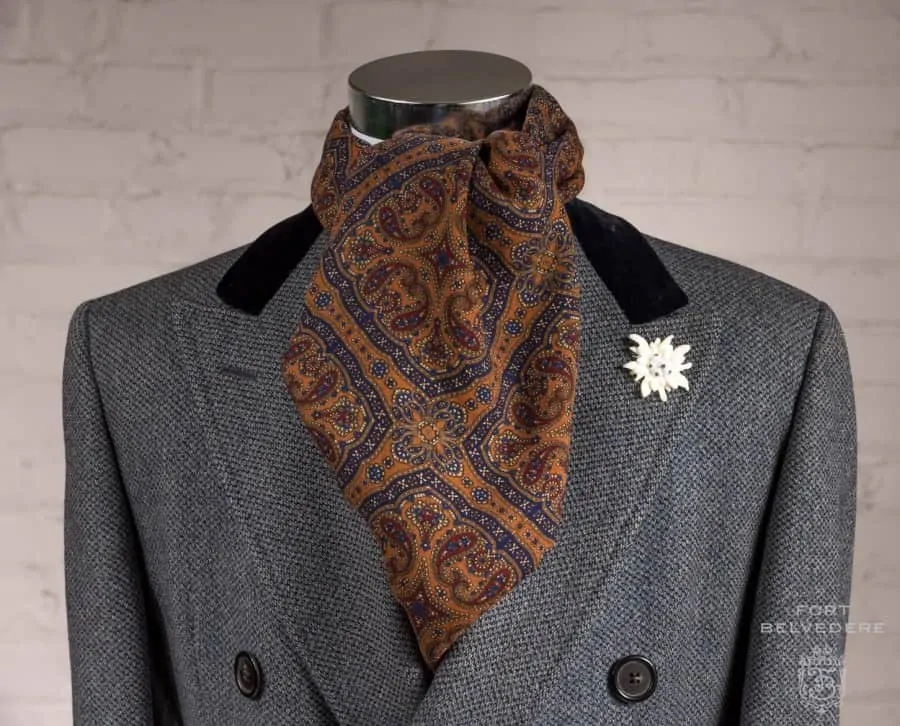
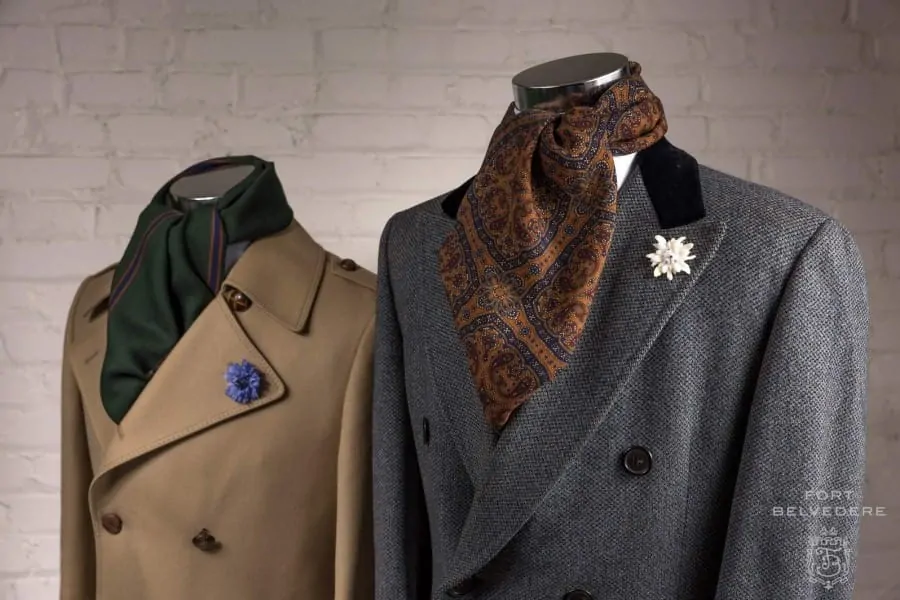
How to Spot a Quality Scarf
1. Look at the Material composition tag. That will weed out all the artificial fibers. If it says wool or cashmere etc. touch it and see if you like it. Better cashmere qualities are softer than inferior ones, however, sometimes inferior qualities are rather soft as well, but they will cause pilling after a few times of wear. Unfortunately, there is no way for you to figure that out before you buy.
2. Size matters: Most men’s scarves are sized 150 cm x 30 cm/60″ x 12″. The problem is, that this is simply too short to tie scarves properly. as such, the ideal dimensions for a cashmere, wool or Alpaca scarf are 180 cm x 30 cm/72″ x 12″. A thinner silk scarf can be 2-3 inches wider or longer, but that’s about it. Otherwise it is too bulky around your neck
3. Fringes: It’s a matter of preference if you want fringes on your scarf are not. Both is perfectly fine, and while cashmere, wool, and alpaca scarves traditionally come with fringes, silk scarves don’t, which is why they have to be added in a separate step.
4. Burn Test. Unfortunately, many scarves are mislabelled, and sometimes they contain artificial fibers although the tag claims, 100% silk, pashmina, silk, wool, etc. The only practical way to know the material composition is to have it tested in a lab which is time intensive and costly. If you have a little sample or a fringe, you can always do the burn test. Natural materials burn differently and smell differently. Some scarves may be blended, but you will always know if you have some artificial fibers in your scarf if it looks like it is melting and if it smells like burned plastic.
| Material | How it Burns | Smell | Residue |
|---|---|---|---|
| Cotton | Burns, doesn't melt | like burning paper or wood | fine grey ash |
| Flax / Linen | Burns, doesn't melt | like burning paper or wood | fine grey ash |
| Wool / Cashmere & other animal hair | Burns but stops when removed from flame, doesn't melt | strong smell like burning hair or feathers | black hollow bead that can be crushed to black powder |
| Silk | Burns, doesn't melt | like burning hair or feathers, but not as strong as wool (silk doesn't contain sulphur) | black hollow bead that can be crushed to black powder |
| Rayon | Burns, doesn't melt | like burning paper or wood | Residue |
| Polyester | shrinks from heat, melts, burns may drip | chemical, sweet | hard cream or black colored bead that can't be crushed |
| Nylon | shrinks from heat, melts, can burn | a bit like celery | hard cream or black colored bead that can't be crushed |
| Acrylic | shrinks from heat, melts, burns and sputters | acrid | hard black bead that can be partially crushed |
| Acetate | shrinks from heat, melts, burns | like burning paper or wood with a bit of vinegar | hard black bead that can be partially crushed |
How To Tie A Scarf
Learn how to tie a scarf in this video by Sven Raphael Schneider – the founder of the Gentleman’s Gazette & Fort Belvedere.
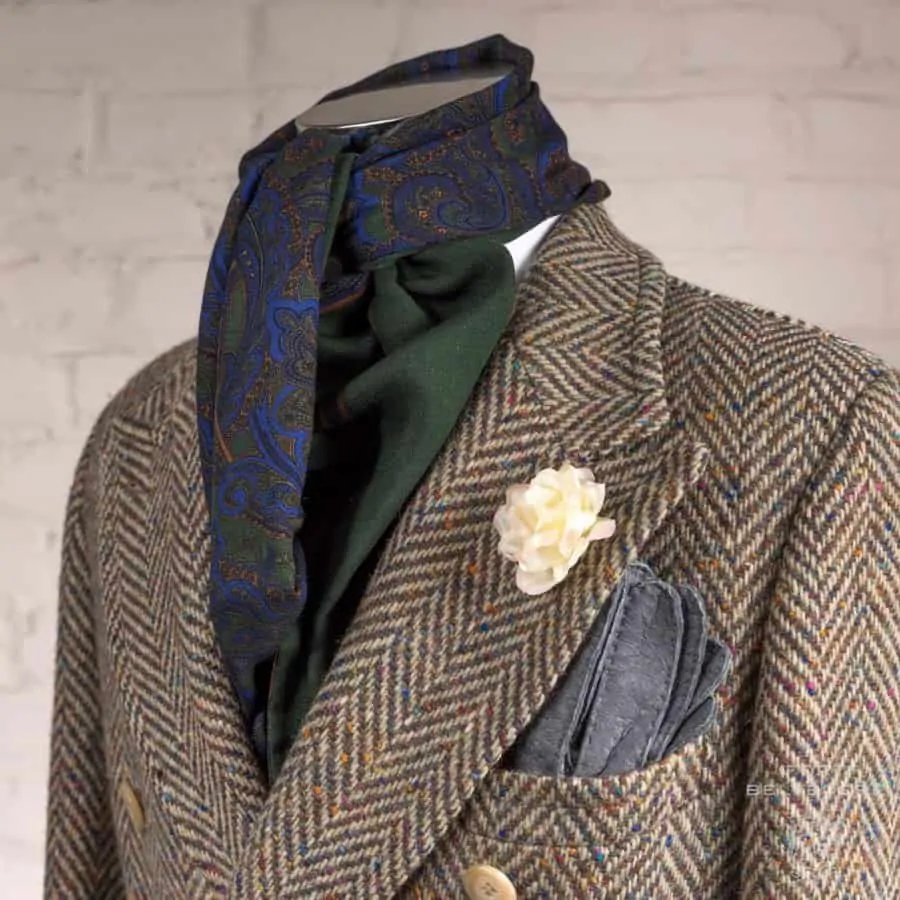
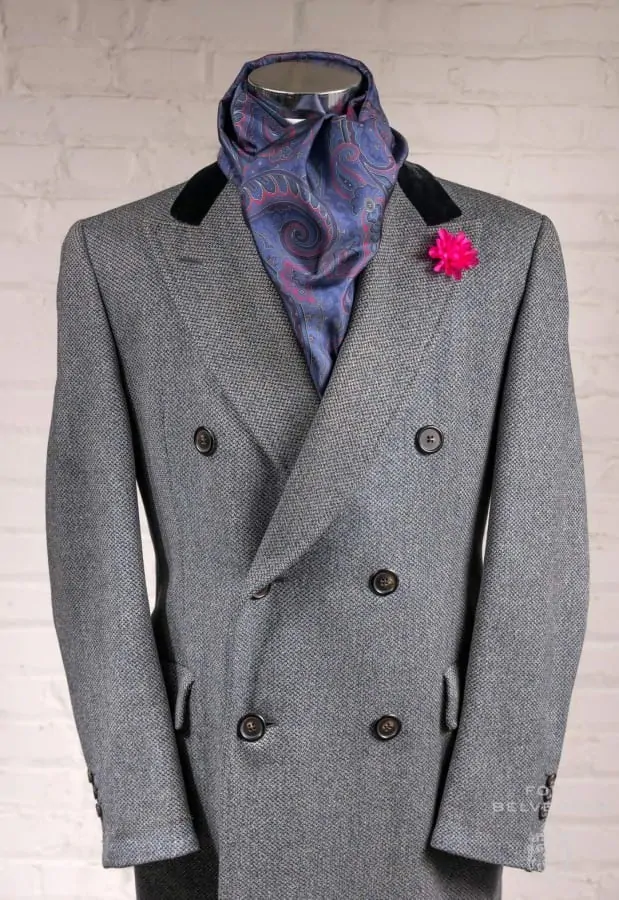
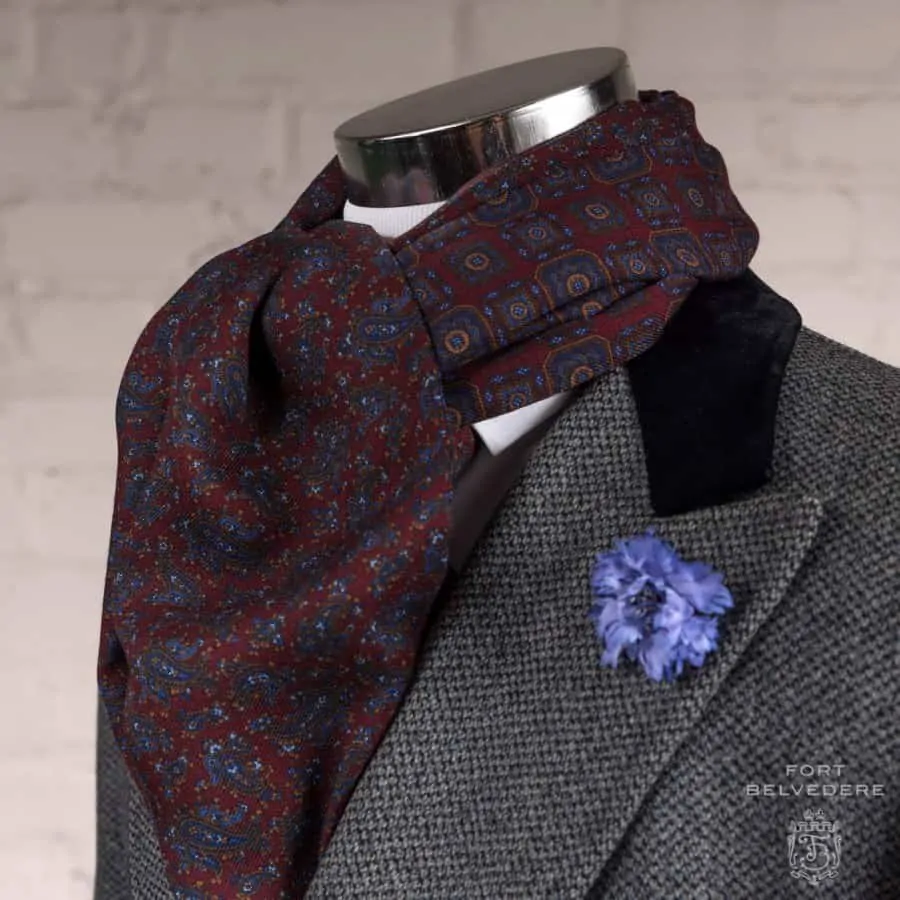
Scarf Maintenance
Once you are done wearing your scarf, fold it and let it lay flat or hang, but don’t just stuff it on your coat pocket. We find folding is the easiest, most convenient way. When you are out and about, hang the scarf over the coat hanger and don’t just stuff it in your sleeve because that’s how most scarves get lost. If your scarf gets wrinkles, you can steam iron it gently at low heat. If you want to ensure not to ruin the surface, use a thin cotton cloth in between the iron and the scarf. Sometime simple steam from a steamer or an iron will do the trick.
Don’t wash your scarves in the laundry, even though some newer machines have gentle cycles and cashmere programs. Either bring them to the dry-cleaner or handwash the scarf using supersaturated liquid soap. Gently press the water from washed cashmere (do not wring it) and let it air-dry hanging up. The weight of the water will ensure it will dry wrinkle-free. Do not put it in the clothes dryer!
Conclusion
Scarves have long been an integral and important part of neckwear for both men and women. Today, just as in past years, the scarf is an exceptionally popular way for men to add personal flair to their wardrobe. While women are blessed with a multitude of accessories, we as men tend to have a more traditional wardrobe that prevents our personality from shining through. Scarves, in addition to providing warmth, are an exceptional way to enhance a wardrobe and add that personality to your attire.
This article was written by Sven Raphael Schneider and J.A. Shapira.
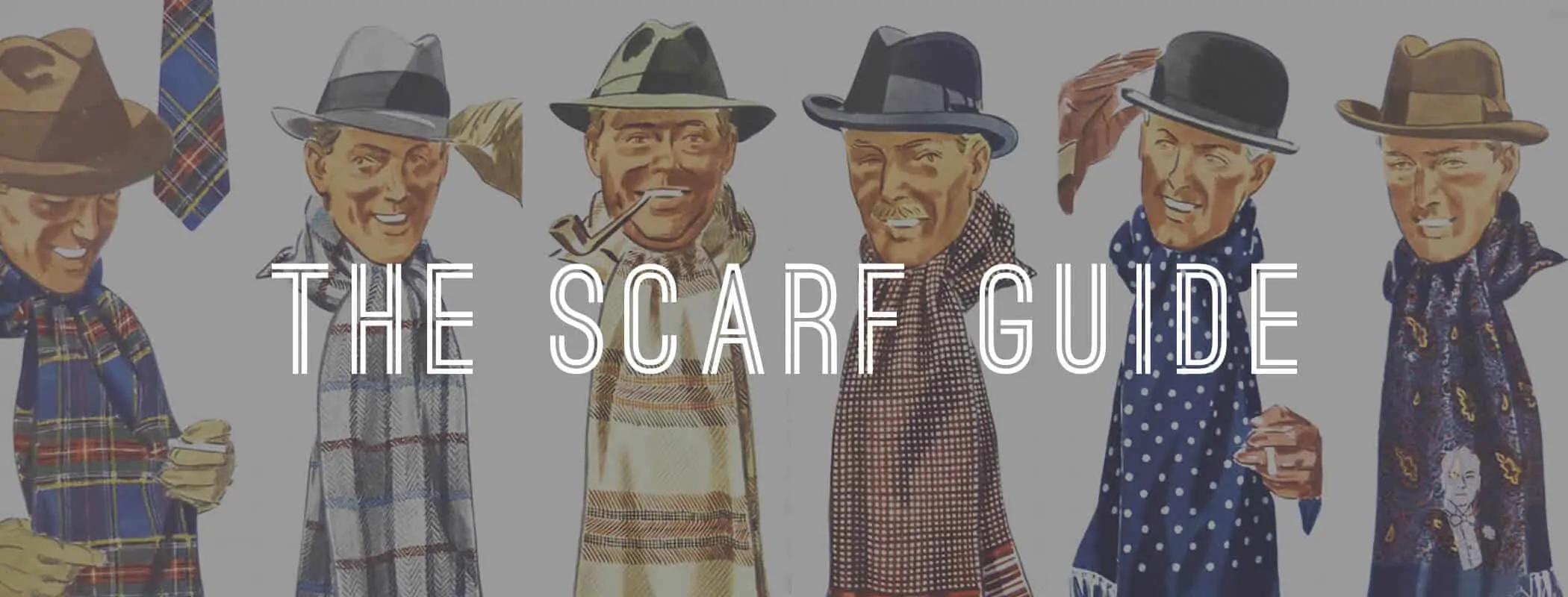
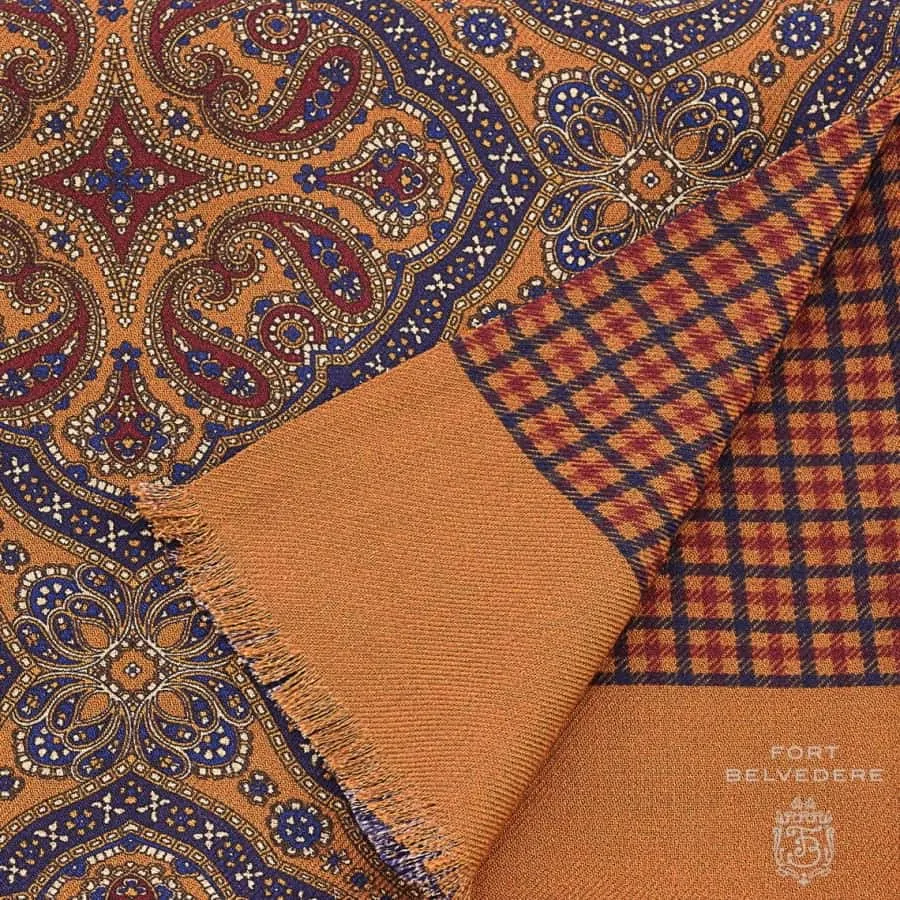
Great article, as always. In preparation for this winter, I recently invested in a Tootals silk scarf to wear with an overcoat. For those who don’t know the company they are one of the oldest British scarf makers (dating back to 1799). A little pricey but well worth checking out!
Thanks for sharing Thomas!
Interesting article – thank you.
It would be great if you could cover neckerchiefs as i have started to wear these and they are absolutely ideal for wearing and leave you feeling less bulky than with a scarf. The problem i have is how to tie them. I currently use a knot but, in all the older films/books (like that of Cary Grant) they use it with a ‘fold over’ (is the term craveat?) technique which is similar to what i remember my grandfather wearing however, i find that this comes undone very quickly, leaving you always checking and tidying it up in public which is a no-no! Please could you offer some advise on materials (mine are very fine gauge wool), size and various techniques for tying.
Regards
Bradley
Great article. I recently acquired a 1930s vintage rayon scarf in navy with red and yellow medallions on it.
What’s your opinion on rayon for patterned overcoat (smaller than normal) scarves?
Rayon is a poor man’s silk.
Quite fitting for the 1930s, wouldn’t you think?
Something of a vintage dresser myself. I suppose in its time Rayon was considered a “miracle fabric”. What I’ve found, in so much as weather permits, you’ll never regret at least bringing a scarf. They normally make you look taller, sophisticated and generally more approachable to females.
Don’t ask me how!
The knot tie scarf was a new variant to me thank you..
Dear Raphael,
I like your opening “It is snowing”. Here in the Netherlands, in North-West Europe, in mid-winter, it ought to snow, but it is now plus 15 Centigrades instead of a bit sub-zero. At this moment, a scarf is too warm…
Hi Sven,
Under “Scarf Maintenance” it says in the second paragraph: Gently press the water from washed cashmere (do not wring it) and a…
The rest is blank. Was there something else that was cut off from this paragraph or did you forget to delete the words “and, a”?
I’m glad I discovered wearing scarves myself. They not only add a fashionable flair to any outfit, but come in handy when the wind starts blowing.
Sven, I enjoyed your article as always. But need I remind ourselves that style is everywhere, even in the texts we write? A gentleman never puts a comma between the subject and the verb of a sentence, as in “Scarves, comma, have been…”. It is a jarring note, rather like wearing a Vacheron Constantin while talking to “youse guys”.
As always, sobriety trumps gaudiness.
Dear Raphael ,
Another great article ; the colour plates of the gentlemen from years back really knock me out , so elegant and manly .
The weather hear in Sydney calls for a scarf only a couple of months in the year . For this I invested in a few nice items including two scarves from Crombie in England ( they make a grand overcoat ) one is a navy cashmere and the other is a rich camel coloured which Crombie describes as Vicuna , a word not much heard these days .
May I have your take on what is Vicuna actually .
Regards
Mark.
Vicuna is an animal from South America that produces the finest hair, which means it feels the softest. It has to be harvested by hand and the yield is minimal. Hence it is very expensive. Unless the overcoat retails for $10,000+ it is not 100% genuine vicuna.
Sometimes people use it to describe the brown color of natural vicuna. or they may have 2% blended in it…
Sven, thankyou for an informative and useful video. I was trying very hard to focus on what you were saying and doing, but must confess to having been distracted by the superb quality overcoat you were wearing!
Hahaha, thanks!
Thank you, Sven, for an engaging and informative article. As a sidenote, working cowboys (yes, they still exist!) in the U.S. Northwest and Western Canada wear a long silk scarf called a wild rag. It is tied in exactly the same way as the once-around as you describe it. Very effective in windy or cold weather, and considered a “fashion statement” in town with the many patterns and prints available. In another life about 20 years ago I was a day rider for ranches in Nevada and Colorado, and the rag was essential when the northern winds were blowing!
If one is distrustful enough to do the burn test in case a scarf has been mislabelled, why should one trust that the fringe is made from the same material as the body of the scarf?
fringe is part of the fabric, you just remove the warp threads. So if just the warp is polyester and the weft is not, then you will not notice it.